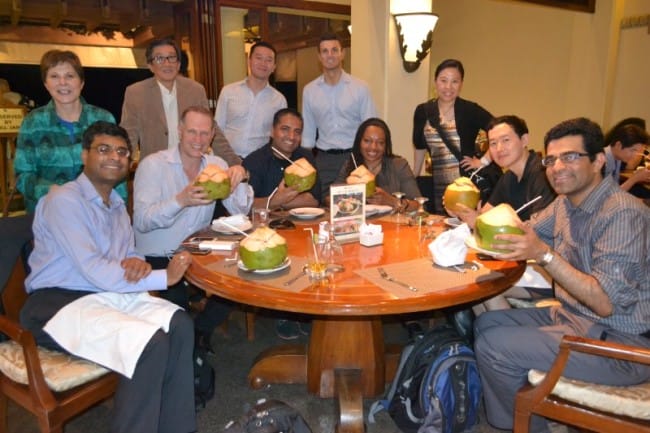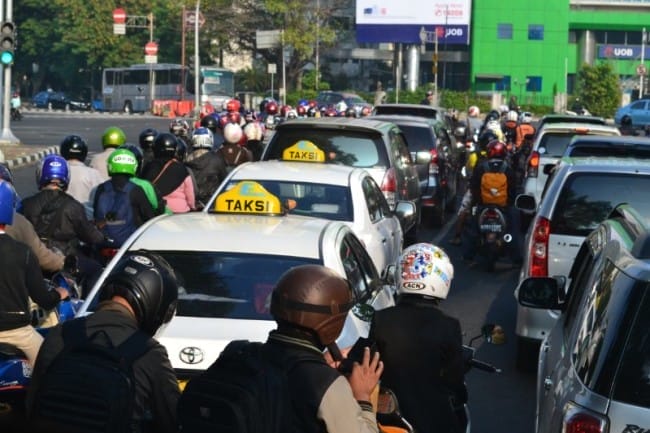
Wharton faculty and students on the Wharton international business course in Indonesia
The average American eye and your computer may read ASEAN as “Asian” misspelled, but Asia watchers know that ASEAN is a trade association consisting of 10 nations, similar to other trade agreement zones such as the Eurozone or the North American Free Trade Agreement (NAFTA.) A recent Global Modular Course (GMC) with the Wharton School at the University of Pennsylvania, in collaboration with Singapore Management University (SMU), brought me closer to ASEAN. On this Wharton international business course, I had an opportunity to visit Singapore, Malaysia and Indonesia over a period of seven tightly packed days in May 2015. I experienced a number of rich insights across these fabulous nations, including learning about cutting-edge urbanization and city planning in Singapore. I noted the catch-up game being played by its next-door neighbor Malaysia, and I got a hands-on experience with palm oil production and the paper mills of Royal Golden Eagle International (RGEI). The Tanoto Foundation expanded my knowledge of corporate social responsibility (CSR), and we witnessed the rising power of newly elected President of Indonesia Joko “Jokowi” Widodo and the changing political landscape of his country.

Plant plucking and nursery maintenance in Indonesia
Historical Background and Implication of Deliberate Decisions
At the end of 1945, the areas bordering the Straits of Malacca were facing recovery from wartime destruction and the sharp decline of colonial rule. Indonesia, the largest and most geographically widespread, was the first to become independent in 1945. Formed in 1948, the Federation of Malaya became independent in 1957. Subsequently, the city-state of Singapore broke off from Malaya and became independent in 1965. At this point, these three post-colonial countries were at somewhat similar levels of development. All three nations were low-income countries with per capita GDP ranging from $56 in Indonesia, to $333 in Malaysia, to $516 in Singapore. Both Indonesia and Malaysia possessed significant natural resources, whereas Singapore, now cut off from Malaysia, was bereft even of water.
Over the past 50 years, the political and economic choices made by these three neighbors have varied, and consequently their growth trajectories have diverged. Today, per capita GDP varies greatly: Indonesia at $3,475, Malaysia at $10,538, and Singapore at a whopping $55,182. Having moved from low-income status to low-middle income status, Indonesia and Malaysia face the challenge of avoiding the “middle-income trap,” the situation where developing economies’ convergence to the development frontier comes to a halt once their per-capita-income reaches a middle-income level. In contrast, Singapore surmounted that challenge, but as an advanced market economy, it now faces the challenge of a small, high-wage country with 5.5 million inhabitants; there is constant need for innovation to remain competitive at this level.
ASEAN: Bringing Southeast Asian Nations Together
The Association of Southeast Asian Nations (ASEAN) was established in 1967 in Bangkok with the signing of the ASEAN Declaration (also known as the Bangkok Declaration) by the ASEAN founding countries, namely Indonesia, Malaysia, Philippines, Singapore and Thailand. Brunei, Vietnam, Laos, Myanmar and Cambodia joined the party later, making up what is today the 19 member states.
While it is natural to compare ASEAN to the Eurozone or NAFTA, there are fundamental differences between these regional political and economic organizations. For example, unlike the Eurozone, ASEAN does not carry a common currency. Although the absence of a common currency makes trade between these nations more difficult, it offers a significant advantage in that each nation can implement its own individual monetary policy. As a region, ASEAN is the seventh largest economy in the world with a combined GDP of $2.4 trillion. Several factors contribute to this growth, such as an expanding and relatively young labor force, the shift from agriculture to manufacturing and transfer of labor from rural to urban sectors, such as the services industry. Indonesia carries the largest population, while Brunei has the smallest share of total population, and Singapore enjoys the highest per capita income.

Traffic congestion in Jakarta. Motorcycle riders multitasking while waiting.
ASEAN has the lowest intraregional trade as compared to other such unions. (The European Union is at 59 percent, NAFTA is at 40 percent, and ASEAN is at 24 percent.) The ASEAN economic community creates a single market of 600 million consumers and a significant production base, enabling free movement of goods, services, capital and people among its member states. As China’s labor costs rise, ASEAN becomes a more attractive location for manufacturing. However, key barriers for ASEAN include different product standards across participating nations, inefficient customs procedures, localized political interest, lack of common currency and various investment restrictions. The ASEAN Economic Community (EOC) of 2015 is expected to boost trade and cooperation in the world and to encourage healthy competition for businesses in the region.
Singapore Urban Planning: A Class above All
Singapore, officially the Republic of Singapore, is a small island city-nation with a 43- by 23-kilometer footprint, boasting a total area of 716 square kilometers (OK, arithmeticians, it is not a perfect rectangle!). The government’s goal of making Singapore a more competitive city led to the mission “to make Singapore a great city to live, work and play.” It’s impressive how this city plans 40 to 50 years out, can offer vertically stacked factories with more efficient use of space, and has flawless control over its traffic and infrastructure. The city utilizes its limited land by erecting high-density developments around rail transit, underground walkways and shopping areas, and co-location of compatible uses under one roof in order to make room for open spaces and parks. With 5.4 million people and 7,600 people per square kilometers, Singapore is the third densest region in the world, right behind Macau and Monaco.
The current master plan is prepared to support a population of 6.9 million residents by 2030. Planning strategies include sufficient and affordable housing with the current home ownership level at 87 percent. Plans include doubling up the rail network, running 800 additional buses, spreading the rail line to enable 85 percent of the residents to be within a 10-minute walk to a train station, and expanding total length of cycling paths from 230 kilometers to 700 kilometers. For Singapore, territorial expansion has been an essential part of economic growth. One of the astounding lessons from this Wharton international business course was to witness the “land reclamation” in various parts of Singapore to create “new” land around the island. Since independence in 1965, the country has expanded by 22 percent, from 58,000 hectares to 71,000 hectares, and the government expects that the nation will need another 5,600 hectares by 2030.
Tanoto Principles: Good for Community, Country, and Company
One of the first lessons in business is that for a business to be successful and sustainable, it must create value for various stakeholders, but determining the stakeholders may not be obvious. One brief but highly effective lesson from the Wharton international business course I learned came from the RGEI’s and Tanoto Foundation’s chief executive officer Sukanto Tanoto WF01, who included the communities and countries his businesses operate in on the list of stakeholders. According to Tanoto, for a business to be truly successful and effective, it must be good for the community, good for the country and good for the company. If you notice carefully, the company is the last among three Cs.
Indonesia Has Something that Japan Would Die For
I visited Japan in May 2014, a year before visiting Indonesia, and wrote 8 Lessons I Learned from Japan, describing my understandings of the nation, and discussing Japan’s efforts in integrating its senior population. Indonesia, however, doesn’t have Japan’s problem as the world’s fourth most populous nation has “youth” in abundance that many of the world’s developed economies can only wish for. The World Bank claims that 50 percent of Indonesians are under 30. On the downside, Indonesia’s labor force is only one-tenth as productive as that of the U.S. and one-third as efficient as Malaysian workers, but labor productivity has been rising.

Glowing Indonesian children with their Wharton guests
Influence of Chinese Families in the ASEAN Region
Singapore ranks as the third richest country in the world based on per capita GDP. Among Singapore’s top 10 richest businesspeople, eight come from Chinese families, while Malaysia’s top 10 richest include eight Chinese and only two Malays (a.k.a., Bumiputera, derived from the Sanskrit word “bhumiputra,” literally meaning “son of the land”). Indonesia has an 85 percent Muslim population, but elite executives are mostly Chinese. Prominent Chinese families of the region include Lees, Gohs, Tanotos, Wees and Kuoks, to name a few. The Chinese business management style includes hands-on experience, transfer of knowledge, qualitative information, holistic information processing (not much marketing research, however), action-driven decision making and extremely high focus on execution.
Does Palm Oil have an Image Problem?
Indonesia is the largest producer of palm oil with an annual production of 30.8 million metric tons. Palm oil is a primary ingredient in many consumer-packaged goods, for example, food, candy, health and beauty products, packaging, cleaners, soap, detergents and candles. Palm oil trees flourish within 5 to 10 degrees of the equator, which makes Indonesia and Malaysia ideally situated to be two of the top producers of this crop. Palm oil is the most price-competitive of all oils, so it attracts customers from developing countries with India being the largest importer of palm oil to support its poor population, while other major importers include China and the European Union. Although palm oil has many health benefits, it is still considered a product for the poor, and it does not stack up well against other competing oils, especially olive oil. Palm oil carries such a stigma due to its high content of saturated fat.
In terms of production in the ASEAN region, Indonesia is somewhat rooted in its colonial past, with major industries being agriculture, mining and manufacturing, with 70 percent of the territory still covered by state-owned forests.
Why Can’t Neighboring Malaysia be Singapore’s Bedroom?
It’s not easy to grow under the shadow of an ultra-developed neighbor and constantly play catchup game, but Malaysia is trying hard. Distance between Singapore and Johor is merely 35 miles, but the trip can take two to four hours, thanks to congested roads and dual immigration on Singaporean and Malaysian sides. If the countries can cooperate, simplify the immigration systems, and establish fast transportation, both sides can benefit as Malaysia has an immense potential to be Singapore’s bedroom community.
On the Wharton international business course, we also had the pleasure to visit Pinewood Group’s state of the art studio in Iskandar where Netflix’s Marco Polo was filmed. The sets, including 51 in Malaysia, required 130 tons of plaster and 1.6 tons of silicone, a construction crew of 400 and an art department of 160. The facility not only enables low-cost filming, but also supplies the Asian cast and extras, which was the key requirement for Marco Polo’s Asian adventures. Beyond big buildings and attractions, for me the unique part of Iskandar was to experience yellow watermelon for the first time ever.
Covering three countries in a week can be stressful but the ASEAN Global Modular Course was definitely worth the stress as we learned a lot about these South Asian nations and how they are relentlessly contributing every single day to change the world. Remarkable experiences, unpretentious people and gracious hosts helped us create memories for life.
Editor’s note: The original version of this post appeared on LinkedIn on July 21, 2015.
The author would like to thank Janice R. Bellace, Samuel Blank Professor of Legal Studies; Prof. Tan Chin Tiong of Singapore Management University; Karen Chan; Erica Stephens; and Dr. Sunita Mishra. References include: www.asean.org and www.ura.gov.sg.

























